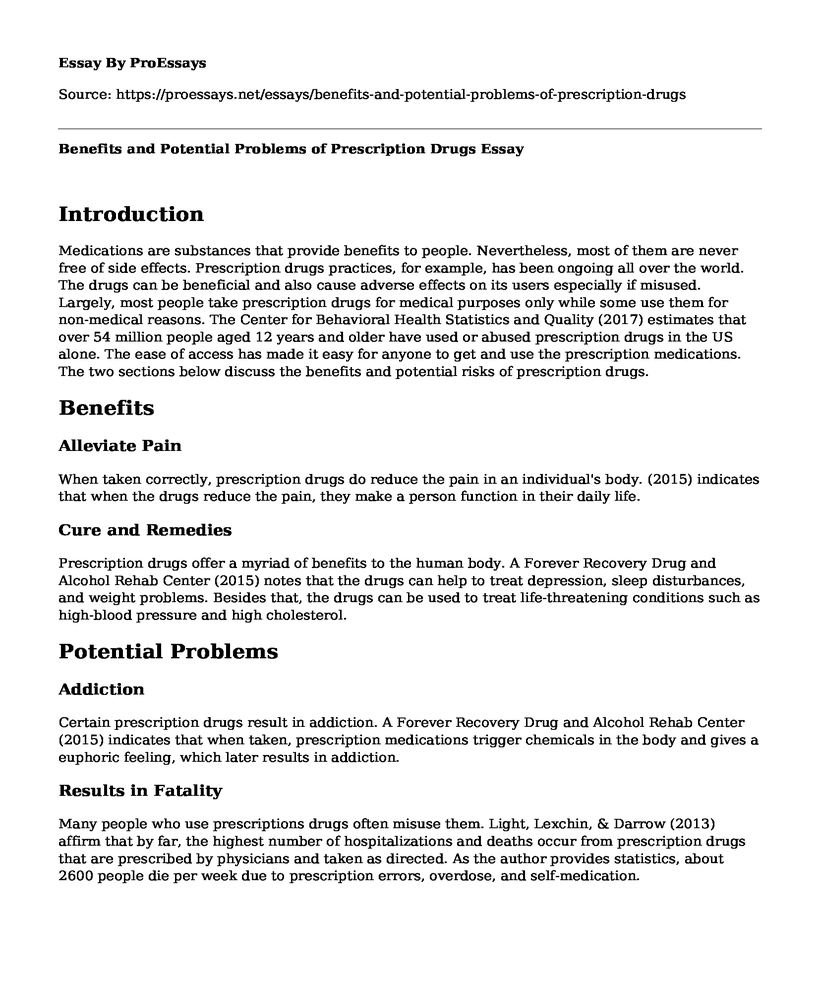Introduction
Medications are substances that provide benefits to people. Nevertheless, most of them are never free of side effects. Prescription drugs practices, for example, has been ongoing all over the world. The drugs can be beneficial and also cause adverse effects on its users especially if misused. Largely, most people take prescription drugs for medical purposes only while some use them for non-medical reasons. The Center for Behavioral Health Statistics and Quality (2017) estimates that over 54 million people aged 12 years and older have used or abused prescription drugs in the US alone. The ease of access has made it easy for anyone to get and use the prescription medications. The two sections below discuss the benefits and potential risks of prescription drugs.
Benefits
Alleviate Pain
When taken correctly, prescription drugs do reduce the pain in an individual's body. (2015) indicates that when the drugs reduce the pain, they make a person function in their daily life.
Cure and Remedies
Prescription drugs offer a myriad of benefits to the human body. A Forever Recovery Drug and Alcohol Rehab Center (2015) notes that the drugs can help to treat depression, sleep disturbances, and weight problems. Besides that, the drugs can be used to treat life-threatening conditions such as high-blood pressure and high cholesterol.
Potential Problems
Addiction
Certain prescription drugs result in addiction. A Forever Recovery Drug and Alcohol Rehab Center (2015) indicates that when taken, prescription medications trigger chemicals in the body and gives a euphoric feeling, which later results in addiction.
Results in Fatality
Many people who use prescriptions drugs often misuse them. Light, Lexchin, & Darrow (2013) affirm that by far, the highest number of hospitalizations and deaths occur from prescription drugs that are prescribed by physicians and taken as directed. As the author provides statistics, about 2600 people die per week due to prescription errors, overdose, and self-medication.
Conclusion
Many people all over the world are addicted to prescription drugs. The dependency on such medications is as a result of the adaptations to exposure of particular prescription medications. Those who try to stop taking the medications face severe withdrawal symptoms that make them relapse and continue to take the drugs. To prevent the potential problems associated with prescription medications, physicians and individuals need to be vigilant to the symptoms and the level of functioning when taking prescription medications.
References
A Forever Recovery Drug and Alcohol Rehab Center (2015). Are the Benefits of Prescription Drugs Worth the Risks? National Association of Addiction Treatment Providers. Retrieved from http://aforeverrecovery.com/blog/drugs/are-the-benefits-of-prescription-drugs-worth-the-risks/
Center for Behavioral Health Statistics and Quality. (2017). 2016 National Survey on Drug Use and Health: Detailed Tables. Substance Abuse and Mental Health Services Administration, Rockville, MD. Retrieved from https://www.samhsa.gov/data/sites/default/files/NSDUH-DetTabs-2016/NSDUH-DetTabs-2016.pdf
Light, D. W., Lexchin, J., & Darrow, J. (2013). Institutional Corruption of Pharmaceuticals and the Myth of Safe and Effective Drugs. Journal of Law, Medicine and Ethics, Vol. 14, No. 3: 590-610.
Cite this page
Benefits and Potential Problems of Prescription Drugs. (2022, Mar 29). Retrieved from https://proessays.net/essays/benefits-and-potential-problems-of-prescription-drugs
If you are the original author of this essay and no longer wish to have it published on the ProEssays website, please click below to request its removal:
- Why Health Care in America Should Be Universal Essay
- Essay Sample on Texas Hospitals Tackle Opioid Abuse Crisis in Emergency Departments
- Oncology Nurses: Providing Physical & Psychological Care for Cancer Patients - Essay Sample
- Conflicts in Nursing Practice: Demotivating Quality Healthcare Services - Essay Sample
- Essay Example on Teenage Moms: The Socio-Economic Impact of Teen Pregnancy
- Essay Example on Testicular Pain: Causes & Symptoms
- Free Essay Example on Getting Back on Your Feet: Post-Illness Advice from a Patient







